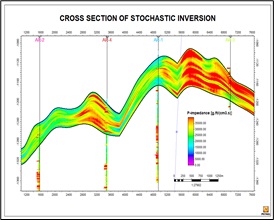Gas Saturated Sandstone Reservoir Modeling Using Bayesian Stochastic Seismic Inversion
DOI:
https://doi.org/10.25299/jgeet.2020.5.1.4503Keywords:
Seismic, geostatistic, stachastic inversion, Bonaparte basinAbstract
This study has been done to map the distribution of gas saturated sandstone reservoir by using stochastic seismic inversion in the “X” field, Bonaparte basin. Bayesian stochastic inversion seismic method is an inversion method that utilizes the principle of geostatistics so that later it will get a better subsurface picture with high resolution. The stages in conducting this stochastic inversion technique are as follows, (i) sensitivity analysis, (ii) well to seismic tie, (iii) picking horizon, (iv) picking fault, (v) fault modeling, (vi) pillar gridding, ( vii) making time structure maps, (viii) scale up well logs, (ix) trend modeling, (x) variogram analysis, (xi) stochastic seismic inversion (SSI). In the process of well to seismic tie, statistical wavelets are used because they can produce good correlation values. Then, the stochastic seismic inversion results show that the reservoir in the study area is a reservoir with tight sandstone lithology which has a low porosity value and a value of High acoustic impedance ranging from 30,000 to 40,000 ft /s*g/cc.
Downloads
References
Anderson, F. dan Gray, D. 2001. Using LMR for Dual Attribute Lithology Identification. SEG Expanded Abstracts. Veritas DGC Inc. San Antonio.
Bohling, G. 2005. Introduction to Geostatistics and Variogram Analysis. Kansas Geological Survey. Kansas.
Cooke, D., and Cant, J., 2010, Model-based Seismic Inversion: Comparing deterministic and probabilistic approaches: Canadian, Society of Exploration Geophysicist Recorder, 35, 28-39.
Dewanto, O. 2009. Well Logging. Universitas Lampung. Lampung.
Dewanto, O., Mulyatno, B.S., Rustadi and Wibowo, R.C. 2017. Determining the Temperature of Shale Material Conversion Into Crude Oil Based on Organic Clay and Organic Carbonate Test Outside Reservoar. International Journal of Mechanical and Mechatronics Engineering, IJMME. Vol. 17, No.05. ISSN: 2077-124X (Online), p. 84-89.
Dorsel, D., dan Breche, L.T. 1997. Kriging, Environmental Sampling and Monitoring Primer. John Wiley and Sons. Virginia.
Doveton, H. 1986. Log Analysis of Subsurface Geology Concepts and Computer Methods. John Wiley and Sons. Virginia.
Francis, A., 2006a, Understanding stochastic inversion: part 1 First Break 24 69–77.
Francis, A., 2006b, Understanding stochastic inversion: part 2 First Break 24 79–84.
Harsono, A. 1997. Evaluasi Formasi dan Aplikasi Log. Schlumberger Oilfield Services. Jakarta.
Isaaks, E., dan Srivastava, R.M. 1989. An Introduction to Applied Geostatistics. Oxford University Press.
Koesoemadinata. 1978. Geologi Minyak dan Gas Bumi. Institut Teknologi Bandung. Bandung.
Lattimer, R., Bahret, S., Sullivan, S., Horine, R., Mills, W., Sturrock, V. 1999. Reservoar Characterization using Geostatistical Inversion for the Amberjack Field, offshore Gulf of Mexico. SEG Journal. Houston.
Mulyatno, B.S., Dewanto, O., Rizky, S. 2018. Determining Layer Oil Shale as New Alternatve Energy Sources Using Core Analysis and Well Log Method. International Journal of Engineering and Technology, IJET. Vol. 7, No. 04.36 ISSN: 2227-524X (Online), p. 941-949.
Rider, M. 1996. The Geological Interpretation of Well Logs. Caithness, Scotland.
Rob, S., dan Mike, B. 2014. Seismic Amplitude an interpreter’s handbook. Cambridge university press.
Russell, B. H. 1991. Introduction to Seismic Inversion Methods, S.N. Domenico. Editor Course Notes Series, Volume 2nd edition.
Schabenberger, O., Gotwey, C. A. 2005. Statistical Methods for Spatial Data Analysis. Chapman & Hall/CRC. USA.
Schlumberger. 1989. Log Interpretation Principles/Aplication. Schlumberger Educational Services. Texas.
Siallagan, F., Dewanto O., dan Mulyatno, B.S. 2019. Analisis Reservoar Migas berdasarkan Parameter Petrofisika dari 7 Sumur di Cekungan Sumatera Selatan. Jurnal Geofisika Eksplorasi. Vol. 3, No. 2.
Srivastava R P and Sen M K, 2009, Fractal-based stochastic inversion of poststack seismic data using very fast simulated annealing, J. Geophys. Eng, 6, p.412.
Srivastava R P and Sen M K, 2010, Stochastic inversion of prestack seismic data using fractal-based initial models, Geophysics, 75, p.47–59.
Stefan, M., 1999, Variogram analysis of magnetic and gravity data, Geophysics, 64, no. 3, 776-784.
Telford, W. M., Geldart, L. P., dan Sheriff, R. E. 1990. Applied Geophysics – Second Edition. Cambridge University Press. USA
Torres-Verdin C, Victoria M, Merletti G and Pendrel J., 1999, Trace-based and geostatistical inversion of 3-D seismic data for thin-sand delineation: an application in San Jorge Basin, Argentina The Leading Edge 18 1070–7.
Webster, R., dan Oliver, M.A. 2007. Geostatistics for Environmental Scientiests Second Edition. John Wiley & Sons Ltd. Inggris.

Downloads
Published
Issue
Section
License
Copyright @2019. This is an open-access article distributed under the terms of the Creative Commons Attribution-ShareAlike 4.0 International License which permits unrestricted use, distribution, and reproduction in any medium. Copyrights of all materials published in JGEET are freely available without charge to users or / institution. Users are allowed to read, download, copy, distribute, search, or link to full-text articles in this journal without asking by giving appropriate credit, provide a link to the license, and indicate if changes were made. All of the remix, transform, or build upon the material must distribute the contributions under the same license as the original.










